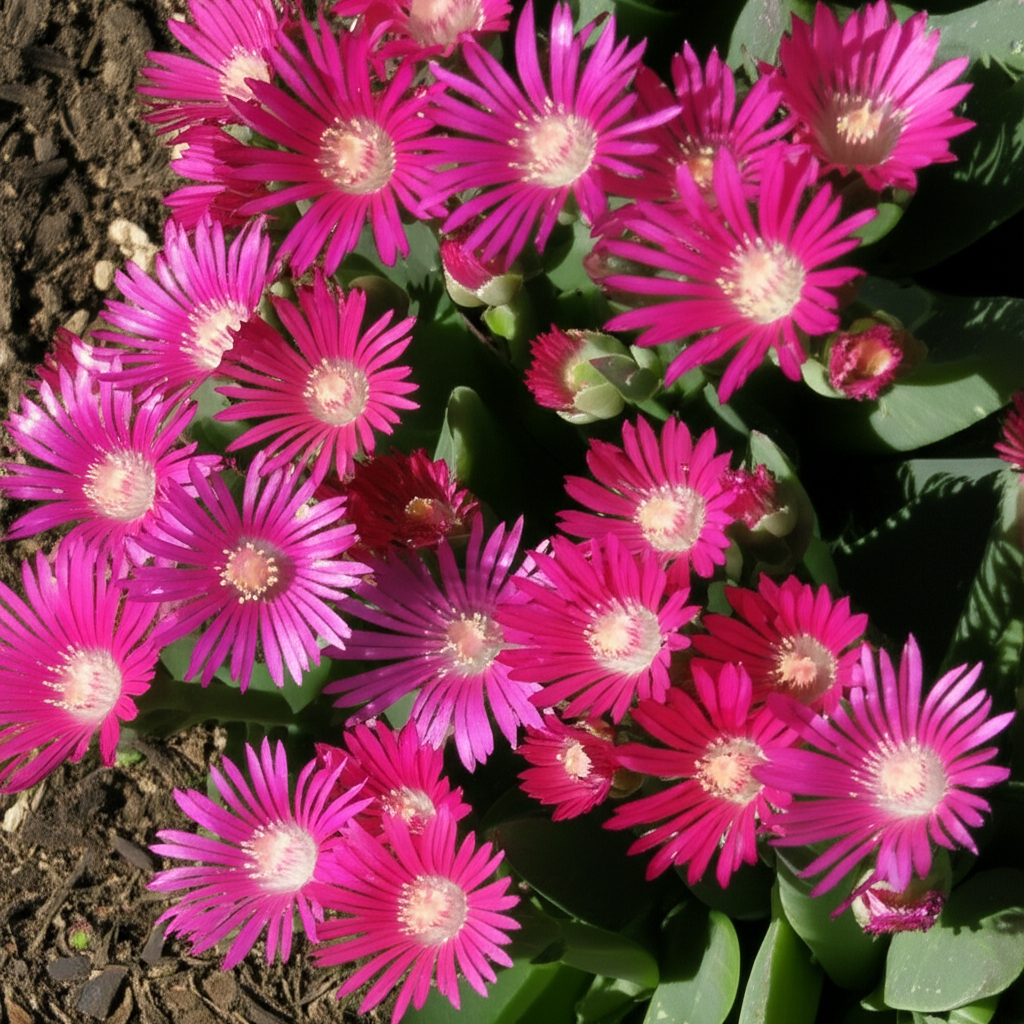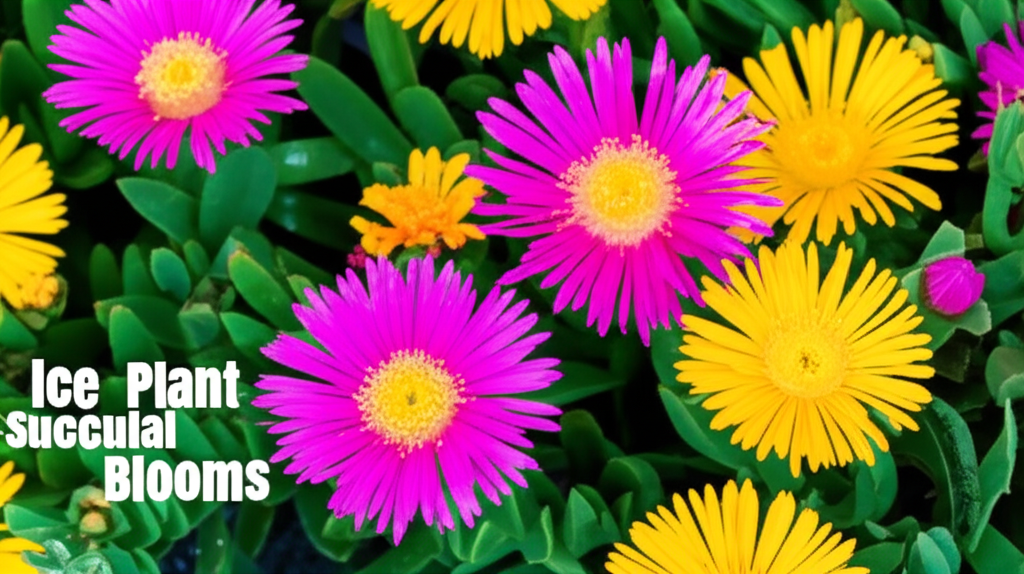Ice plants, members of the Aizoaceae family, are a diverse and captivating group of succulents known for their vibrant, daisy-like flowers and unique, often crystalline, leaf structures. These resilient plants are surprisingly adaptable, thriving in arid conditions and bringing a splash of color to even the most challenging landscapes. While their drought tolerance is a hallmark, understanding their seasonal blooming patterns is key to maximizing their ornamental potential and ensuring their continued health. This comprehensive calendar will guide you through the blooming cycles of popular ice plant varieties, offering insights into their care and the magic they bring throughout the year.
Understanding Ice Plant Blooming Cycles
The blooming period of ice plants is not a single, fixed event but rather a spectrum influenced by several factors, including species, cultivar, climate, and specific environmental conditions. Generally, most ice plant varieties are renowned for their spring and summer flowering, but certain types may surprise you with off-season blooms or extended flowering periods.
Several key elements contribute to when your ice plant will grace you with its blooms:
- Light Exposure: Ample sunlight is crucial. Most ice plants require at least six hours of direct sunlight daily to initiate flowering.
- Temperature: While they tolerate heat, extreme temperatures can sometimes inhibit or shorten blooming. Moderate warmth is ideal.
- Watering: While drought-tolerant, a slight increase in watering during their active growth and blooming periods can encourage more prolific flowering. However, overwatering is a common pitfall that can lead to root rot and fewer blooms.
- Soil Drainage: Well-draining soil is paramount. Stagnant water will prevent flowering and harm the plant.
- Age and Maturity: Younger plants may focus on establishing their root systems and foliage before dedicating energy to flowering.
Key Ice Plant Varieties and Their Blooming Habits
To provide a more detailed understanding, let’s explore some common and beloved ice plant varieties and their typical blooming seasons. It’s important to remember that these are general guidelines, and your specific plant may bloom slightly earlier or later.
Delosperma (Hardy Ice Plants)
Hardy ice plants, belonging to the genus Delosperma, are celebrated for their ability to withstand colder temperatures, making them a fantastic choice for a wider range of climates. They typically present a spectacular show of color in late spring to early summer.
- Delosperma cooperi (Cooper’s Ice Plant): This is one of the most popular and reliably blooming Delosperma species. It typically flowers from late spring through summer, with a peak in June and July. Its vibrant magenta-pink flowers are a stunning sight.
- Delosperma lavisiae: Known for its cheerful yellow flowers, Delosperma lavisiae also blooms from late spring into early summer.
- Delosperma echinatum (Hairy Ice Plant): While known for its unique, segmented leaves, this species can produce small, yellowish-green flowers, often appearing in late spring.
Mesembryanthemum (Common Ice Plants)
The genus Mesembryanthemum includes many of the commonly recognized ice plants, often found in coastal gardens and rockeries. These are typically more sensitive to frost than their hardy counterparts.
- Mesembryanthemum crystallinum (Common Ice Plant): This annual or biennial species is famous for its shimmering, crystalline epidermal cells, which give it its name. It typically flowers from early summer to autumn. The flowers are often pale pink or white.
- Mesembryanthemum cordifolium (Heartleaf Ice Plant): A popular groundcover, this species boasts an extended blooming period, often starting in late spring and continuing throughout the summer and into the fall, especially in milder climates. It offers flowers in shades of pink, purple, and magenta.
Lampranthus (Trailing Ice Plants)
Lampranthus species are often referred to as trailing ice plants due to their often cascading growth habit. They are known for their incredibly dense and vibrant floral displays.
- Lampranthus spectabilis: This is a showstopper, renowned for its prolific blooming. It typically flowers in spring, with a peak display in April and May. The flowers are often a brilliant pink or purple.
- Lampranthus aureus: Exhibiting bright yellow to orange flowers, Lampranthus aureus also blooms in spring, often overlapping with L. spectabilis.
- Lampranthus blandus: Producing lovely pink flowers, L. blandus typically blooms in late spring.
Aptenia (Heartleaf Ice Plant – distinct from Mesembryanthemum cordifolium)
While sometimes confused with Mesembryanthemum cordifolium, Aptenia species have their own unique characteristics.
- Aptenia cordifolia (Heartleaf Ice Plant): This vigorous groundcover produces small, bright magenta flowers that can appear sporadically throughout the warmer months, from late spring through autumn, especially when conditions are favorable.
Seasonal Blooming Calendar: A General Overview

This calendar provides a general guide to when you can expect your ice plants to be in bloom. Remember that local climate and specific growing conditions will influence these timelines.
Spring (March – May)
Spring is a pivotal time for many ice plants as they emerge from dormancy and prepare to showcase their blooms.
- Early Spring (March-April): In milder climates, you might start to see the first signs of flowering from some Lampranthus species, such as Lampranthus spectabilis and Lampranthus aureus. Trailing varieties may begin to put on a show.
- Mid-Spring (April-May): This is typically the peak blooming season for many Lampranthus varieties. Delosperma cooperi may also begin to flower. Groundcover types like Mesembryanthemum cordifolium will start their extended blooming period.
- Late Spring (May): The spring bloom continues strongly for Lampranthus and Delosperma. Mesembryanthemum crystallinum may start to flower as well.
Summer (June – August)
Summer is often the period of sustained color for many ice plants, with some varieties reaching their peak or continuing their impressive displays.
- Early Summer (June): Delosperma cooperi is usually in full bloom. Mesembryanthemum cordifolium will be flowering prolifically. Mesembryanthemum crystallinum will be in its prime flowering stage.
- Mid-Summer (July): Many ice plants continue to bloom well into summer. The heat can sometimes cause a slight lull in flowering for some species, but generally, the color persists.
- Late Summer (August): Flowering may start to wane for some early bloomers, but varieties like Mesembryanthemum cordifolium and Aptenia cordifolia can continue to produce flowers, especially if they receive adequate (but not excessive) water and the heat isn’t extreme.
Autumn (September – November)
As temperatures begin to cool, some ice plants may offer a final burst of color, particularly those with longer blooming seasons.
- Early Autumn (September): Mesembryanthemum cordifolium and Aptenia cordifolia can still be flowering, providing a welcome splash of color as the season begins to transition.
- Late Autumn (October-November): Bloom production will significantly decrease for most ice plants as they prepare for cooler weather or dormancy. In very mild climates, a few stray blooms might still be visible.
Winter (December – February)
Generally, ice plants do not bloom in winter, especially in regions experiencing frost or significant cold. They are dormant or semi-dormant during this period. Their crystalline foliage, however, often provides visual interest even without flowers.
Key Facts and Comparison of Popular Ice Plants
To help you choose the right ice plant for your garden and understand their blooming characteristics, here’s a comparative table.
| Species/Genus | Common Name | Typical Blooming Season | Flower Color | Hardiness Zone (Approximate) | Growth Habit |
|---|---|---|---|---|---|
| Delosperma cooperi | Hardy Ice Plant | Late Spring – Summer | Magenta-pink | Zones 5-10 | Low-growing, spreading |
| Mesembryanthemum cordifolium | Heartleaf Ice Plant | Late Spring – Autumn | Pink, Purple, Magenta | Zones 9-11 | Spreading groundcover |
| Lampranthus spectabilis | Trailing Ice Plant | Spring | Pink, Purple | Zones 9-11 | Cascading, trailing |
| Mesembryanthemum crystallinum | Common Ice Plant | Early Summer – Autumn | Pale Pink, White | Zones 9-11 (often grown as annual) | Low-growing, sprawling |
| Aptenia cordifolia | Heartleaf Ice Plant | Late Spring – Autumn (sporadic) | Magenta | Zones 9-11 | Vigorous groundcover |
Maximizing Ice Plant Blooms: Care and Tips
Achieving the most spectacular blooms from your ice plants involves providing them with the right conditions and a little seasonal attention.
Planting and Soil
- Location: Choose a spot that receives full sun (at least 6 hours daily).
- Soil: Use a gritty, well-draining soil mix. A cactus or succulent mix is ideal, or amend regular potting soil with perlite or pumice. Avoid heavy, clay soils.
- Container Planting: Ensure containers have drainage holes.
Watering and Fertilizing
- Watering: Allow the soil to dry out completely between waterings. In spring and summer during active growth and flowering, you may need to water more frequently than in winter. Overwatering is the most common cause of ice plant failure.
- Fertilizing: Ice plants are not heavy feeders. Feed sparingly in spring with a balanced, diluted liquid fertilizer or a specialized succulent fertilizer. Excessive nitrogen can lead to lush foliage at the expense of blooms.
Pruning and Maintenance
- Deadheading: While not strictly necessary for all ice plants, removing spent flowers can sometimes encourage more blooms and keep the plant tidy.
- Trimming: After flowering, you can trim back leggy growth to encourage a bushier habit. This is especially beneficial for groundcover varieties.
- Overwintering: In colder climates, hardy ice plants (Delosperma) can often survive outdoors if protected. Non-hardy varieties will need to be brought indoors or treated as annuals.
Troubleshooting Common Blooming Issues
If your ice plant isn’t blooming as expected, consider these common issues:
Lack of Sunlight
- Problem: Insufficient light is the most frequent culprit.
- Solution: Relocate the plant to a sunnier spot.
Overwatering
- Problem: Soggy soil leads to root rot and inhibits flowering.
- Solution: Allow soil to dry out completely. Ensure excellent drainage. Reduce watering frequency, especially during cooler months.
Poor Soil Drainage
- Problem: Roots sitting in water will prevent healthy growth and flowering.
- Solution: Repot into a well-draining mix or amend the existing soil.
Excessive Nitrogen Fertilization
- Problem: Too much nitrogen promotes leaf growth over flower production.
- Solution: Fertilize sparingly and use a balanced or bloom-boosting formula.
Plant Immaturity
- Problem: Young plants may be focusing energy on growth.
- Solution: Be patient. Ensure optimal conditions, and it will likely bloom in subsequent seasons.
Pros and Cons of Ice Plant Blooming Cycles
Understanding the advantages and disadvantages of their flowering patterns helps in garden planning.
| Aspect | Pros | Cons |
|---|---|---|
| Timing | Spring and summer blooms provide vibrant color during peak garden season. Extended blooming in some varieties offers longer-lasting visual appeal. | Many varieties are not winter bloomers, meaning a lack of color in colder months. Off-season blooming can be sporadic and less prolific. |
| Flower Show | Can produce incredibly dense and spectacular displays of color, transforming landscapes. | Some varieties have smaller, less showy flowers. Bloom quality can be affected by weather extremes. |
| Care Requirements | Generally low maintenance, requiring minimal watering and feeding, which aligns with their blooming needs. | Overwatering, a common mistake, can significantly reduce or prevent flowering and lead to plant death. |
| Adaptability | Hardy varieties (Delosperma) offer blooms in a wider range of climates. | Less hardy varieties require protection in colder regions, limiting their blooming season or necessitating container culture. |
Conclusion
The ice plant succulent, with its diverse species and captivating blooms, offers a rewarding experience for any gardener. By understanding their seasonal blooming calendar and adhering to their basic care requirements – ample sunlight, well-draining soil, and judicious watering – you can unlock their full potential. Whether you’re drawn to the hardy Delosperma carpeting your rock garden in spring or the cascading brilliance of Lampranthus, these resilient succulents promise to bring a vibrant and unique touch to your landscape throughout their blooming seasons. Observe your plants, learn their individual rhythms, and enjoy the dazzling spectacle they provide.


